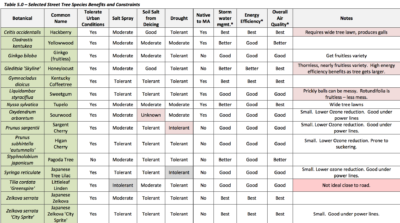.jpg?width=300&name=IMG_4406%20(1).jpg) UPDATE 2018 (Originally posted June 2017): Congratulations to the team we interviewed for this podcast. They received an American Planning Association Achievement Award at the National Planning Conference for their work on this project.
UPDATE 2018 (Originally posted June 2017): Congratulations to the team we interviewed for this podcast. They received an American Planning Association Achievement Award at the National Planning Conference for their work on this project.
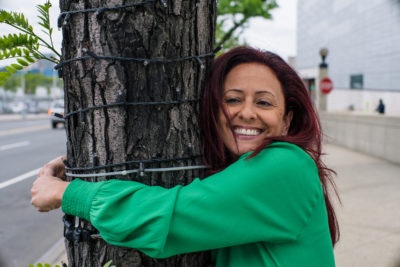 Have you ever been called (or called someone else) a “treehugger”? I personally wear that moniker as a badge of honor. For decades that has been a catchall term for anyone who supports protecting wild forests, clean air and water, open spaces, sustainable places, and so on. But aside from the “hugging” part about loving and caring, the one word in our language that has come to symbolize sustainability and environmental protection is “trees.”
Have you ever been called (or called someone else) a “treehugger”? I personally wear that moniker as a badge of honor. For decades that has been a catchall term for anyone who supports protecting wild forests, clean air and water, open spaces, sustainable places, and so on. But aside from the “hugging” part about loving and caring, the one word in our language that has come to symbolize sustainability and environmental protection is “trees.”
So it’s no surprise that communities across the country take their trees seriously.
I recently talked to a few colleagues (my first multi-guest SAS Talk with Kim podcast!) about the trees in Lawrence, Massachusetts, the Green Streets Lawrence program and a recent Health Impact Assessment of the program, which was a collaboration among the American Planning Association’s Sustainable Communities Division (APA-SCD), the Massachusetts Chapter of the American Planning Association and Groundwork Lawrence. After six months of research, workshops, and meetings, the final product is a comprehensive assessment and evaluation of the physical, environmental and social impacts of street tree planting in Lawrence.
 Take a listen to my conversation with Angela Vincent (Merrimack Valley Planning Commission and APA-SCD volunteer), Brad Buschur (Project Director with Groundwork Lawrence) and Neil Angus (Devens Enterprise Commission and APA-SCD volunteer) about the project.
Take a listen to my conversation with Angela Vincent (Merrimack Valley Planning Commission and APA-SCD volunteer), Brad Buschur (Project Director with Groundwork Lawrence) and Neil Angus (Devens Enterprise Commission and APA-SCD volunteer) about the project.
It’s also worth downloading their full report -- and checking out some of their cool (and replicable) graphics.
Here’s a basic overview of what we cover in the podcast:
Quick Background
Groundwork Lawrence operates the “Green Streets” program. Here’s their summary: “In 2016, with support from the Massachusetts Executive Office of Energy and Environmental Affairs, GWL has embarked on a journey to plant 2400 trees in Lawrence over the next three years as a part of our Green Streets program. Since the beginning of funding, 85 trees have been planted in targeted locations including the South Common and Arlington neighborhoods. Planting trees in residential neighborhoods reduces energy bills, absorbs flood water, improves water quality, and reduces runoff and erosion.Green Streets works to increase vital tree cover in Lawrence. By working with new homeowners who have front or side yards within 20’ feet of a public way, we are able to plant trees that benefit the community and ensure that each tree has a steward.”
Health Impact Assessment
For those of us working in urban sustainability, we have long communicated some of the basic values of trees in standard terms: cooler temperatures (I’ve written about Louisville, Kentucky’s efforts to combat the urban heat island effect), lower energy bills, improved stormwater management, air quality, and even livability and home value.
But what about viewing -- and talking about -- them through the health lens? We often think about health as what we eat and whether we exercise or have habits like smoking, but the way our communities are designed has an impact on our physical and mental health. That’s especially true when it comes to the trees that line our streets.
And that was the crux of this Health Impact Assessment and my chat with the team. Now would be a good time to listen to that chat.
The report offers nine recommendations (the report includes resources for each:
- Create Additional Focused Messaging
- Create a Video about the Green Streets Program
- Create a Friendly Neighborhood Competition
- Augment Existing Planting Guidelines
- Develop a Tree Stewardship Program
- Use i-Tree for Monitoring
- Adopt a Tree Preservation/Protection Ordinance in Lawrence
- Adopt a Street Tree Bylaw/Ordinance
- Seek Additional Funding and Support
And three related deliverables:
- Tree Species Analysis and Recommendations
- Infographic, Tagline and Logo
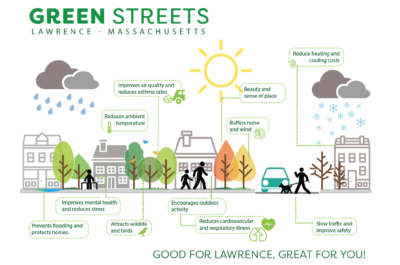
- Educational Messaging. (It is worth noting that Lawrence is 70% Latino so all of the collateral has a Spanish-language version to make it accessible to the whole community.)
Drilling Down to the Nutrition Label Level
One of the things that caught my attention in the Lawrence report was the use of a
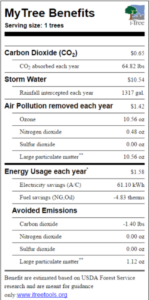 “nutrition label” to talk about the trees. They did a breakdown of individual tree species with a detailed analysis of their ecosystem services (for example, which type would have the most impact on air quality, on energy savings, etc). But that information presented in a spreadsheet would make most people’s eyes glaze over. Turn it into a nutrition label like you see on food and beverage products, and people intuitively “get it.” It’s a great way to outline in qualitative and quantitative -- and most importantly *visual* -- terms the benefits of trees to community members and decision-makers.
“nutrition label” to talk about the trees. They did a breakdown of individual tree species with a detailed analysis of their ecosystem services (for example, which type would have the most impact on air quality, on energy savings, etc). But that information presented in a spreadsheet would make most people’s eyes glaze over. Turn it into a nutrition label like you see on food and beverage products, and people intuitively “get it.” It’s a great way to outline in qualitative and quantitative -- and most importantly *visual* -- terms the benefits of trees to community members and decision-makers.
You, too, can do the same thing; they used the My i-Tree tool.
Another compelling visual in the report is a “word cloud” based on their community 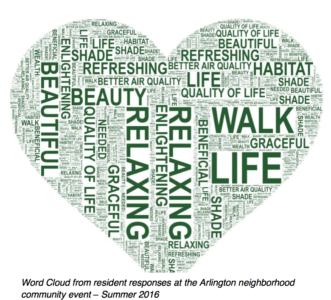 outreach, and I’m sure many of us can relate to the words people associated with trees: beauty, relaxing, shade, refreshing. The exercise also clued them into some concerns that residents have about planting more trees such as pollen and leaf litter.
outreach, and I’m sure many of us can relate to the words people associated with trees: beauty, relaxing, shade, refreshing. The exercise also clued them into some concerns that residents have about planting more trees such as pollen and leaf litter.
What results are they seeing at this early stage? So far they’ve planted 300 trees with another 80 already in the pipeline. Plus they told me that key aspects of their program are being replicated in communities across Massachusetts. And, based on my conversation, could be across the country.
Are #trees trending? One can only hope that more communities will get back to the roots (pun intended) of sustainability and livability with a focus on trees. From the Arbor Foundation’s “Tree City USA” designations to recent studies highlighting how planting trees in cities can save lives, trees should be prominent on your radar screen.
Be sure to listen to our podcast to get tips from Lawrence!
Side note: I’m also going to put this relatively new book, Urban Forests: A Natural History of Trees and People in the American Cityscape on my to-read list.


